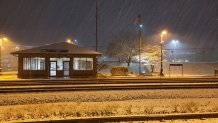Ready or not Chicago, it's snowing.
According to NBC 5 Storm Team, snow showers that developed overnight began to overspread the area starting at around 3:30 a.m. Tuesday morning. And as the sun rises, big, chunky snow flakes will continue to melt as they hit the ground, creating a slick and slippery morning commute.
Read More: Tracking Chicago Snow Totals, Accumulation as Area Sees First Measurable Snowfall of 2022
According to NBC 5 Chicago traffic reporter Kye Martin, several spinouts have already created backups across roadways, and drive times are on the rise.

South of the city, a winter weather advisory for LaSalle, Grundy, Will and Kankakee counties went into effect at 4 a.m., where 1-2 inches of snow is expected. According to the National Weather Service, that advisory will expire at noon.
The brunt of the storm though is expected to impact McHenry, Lake and DuPage counties, as well as northern and central Cook counties. There, a winter weather advisory will go into effect at 6 a.m. Tuesday and will remain in effect until 6 a.m. Wednesday.

According to the NWS, snow is expected to fall on-and-off throughout that time frame, with flakes creating slushy accumulations on roadways. Between 2-to-5 inches of snow could fall in parts of the area, according to forecast models.
Local
Feeling out of the loop? We'll catch you up on the Chicago news you need to know. Sign up for the weekly Chicago Catch-Up newsletter.
Along the lakefront however, the snow accumulation is expected to be limited, thanks to warmer air blowing off the water.
To the west, a winter weather advisory will take effect at 6 a.m. Tuesday in DeKalb, Kane, Kendall and southern Cook counties. That will run through midnight, with accumulations of 1-to-3 inches possible.
How Cold Will it Be?
According to NBC 5 Storm Team, temperatures are expected to be above freezing, climbing into the upper 30s. A high of 39 degrees is expected around 3 p.m., according to forecast models.
However, while a mix of rain and snow will continue through at least Wednesday, much colder temperatures are expected to set in by Friday.
How Much Snow Accumulation is Expected?
The Chicago area can expect to see 1-3 inches of snow accumulation, NBC 5 Storm Steam says, with totals reaching up to 5 inches in some areas.
Track the Storm
Winter Driving in Chicago
According to NWS, slippery road conditions are expected during Tuesday's morning and evening commutes.
Chicago's Office of Emergency Management and Communications suggests people allow more time for driving, give extra space between vehicles and make room for emergency responders.
OEMC works in conjunction with Chicago's Department of Streets and Sanitation, which has 425,000 tons of salt and a fleet of more than 200 trucks ready to be deployed across the city.
"We just ask people to be conscious that it is the first snow," said Cole Stallard, commissioner of the Department of Streets and Sanitation. "It is in the morning rush hour. Talk to those young drivers in the house that this may be their first time heading off to school driving."
When Does Chicago Typically See its First Snowfall?
According to the National Weather Service, the average date that Chicago typically sees its first measurable snowfall is Nov. 18.
O'Hare International Airport has seen two ends of extremes in recent years, with 2019's first measurable snowfall coming on Oct. 30, the seventh-earliest measurable snowfall in Chicago since 1967.
Read More: Chicago Could See a Snowier Winter Than Normal. See NOAA's New Predictions
Just last year, Chicago saw its latest first measurable snowfall of all-time, according to the National Weather Service. Snow did not fall at O'Hare Airport until Dec. 28, when 1.5 inches of snowfall were recorded.
The earliest snowfall record was set on Oct. 12, 2006, when 0.3 inches of snow fell at O'Hare.
Here's a look at when the city saw its first snowfall over the past 10 years, and how much snow fell:
- 2012: Dec. 20, 0.2 inches
- 2013: Nov. 11, 0.4 inches
- 2014: Oct. 31, 0.1 inches
- 2015: Nov. 20, 4.2 inches
- 2016: Dec. 4, 6.4 inches
- 2017: Nov. 10, 0.1 inches
- 2018: Nov. 9, 1 inch
- 2019: Oct. 30, 1.2 inches
- 2020: Nov. 24, 0.7 inches
- 2021: Dec. 28, 1.5 inches



